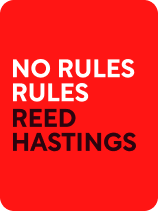

This article is an excerpt from the Shortform book guide to "No Rules Rules" by Reed Hastings. Shortform has the world's best summaries and analyses of books you should be reading.
Like this article? Sign up for a free trial here .
What is the Netflix feedback process? How does their four-step approach enhance innovation and encourage success?
The Netflix feedback process is a four-step approach to proposing ideas. It is also known as the Netflix Innovation Cycle.
Read on for more about Netflix’s feedback culture and the four-step innovation process.
Netflix: Feedback and Innovation
To help employees succeed, Netflix has developed a four-step approach to proposing ideas, called the Netflix Innovation Cycle. Let’s examine each of the four steps.
Step 1: Peer Feedback
Netflix’s feedback culture is open and creative. Although you don’t need approval to move forward on an idea, leadership expects you to make well-informed decisions, which includes gathering and considering feedback from managers and colleagues. There are two ways to go about this for the first step of the Netflix feedback process:
- “Farm for dissent”: Make a memo explaining your idea and share the document among dozens of coworkers, asking for their input. Coworkers can insert comments in the document responding to specific aspects of your proposal, and other colleagues can see and respond to those comments. Alternatively, you can create and share a spreadsheet in which you ask coworkers to rate your idea from -10 to 10 and then explain their ratings. You’re likely to get a mix of support and dissent, all of which will give you insight as you alter, abandon, or move forward with your idea. Additionally, this process reinforces a culture in which people can give and receive constructive criticism.
- “Socialize the idea”: Schedule multiple meetings with colleagues and managers in which you explain your idea and talk through it. This is a way to flesh out and stress-test your proposal while getting feedback and suggestions for possible improvements.
As we discussed in Chapter 2, Netflix’s culture of candor makes it an act of disloyalty to withhold disagreement or skepticism about an idea, because speaking up ignites discussion that could prevent someone from moving forward with a disastrous idea. The Netflix feedback process is a critical first step in the Netflix Innovation Cycle because it actively works against the human inclination to conform, which can lead people to go along with bad ideas.
Step 2: Test Out Big Ideas
When a proposal involves a lot of time, work hours, and resources, it’s critical to test the idea on a smaller scale before committing to it full-out. Most companies encourage some form of testing out ideas—but Netflix urges employees to test ideas even if the bosses disagree with them.
For example, in 2015, Hastings and his chief product officer were both set against adding a feature that would allow Netflix users to download content to watch offline. Although other services like Amazon Prime offered downloading, Hastings was convinced that the company needed to focus on streaming only. Despite Hastings’s very public opinion, a senior researcher decided to test the idea: He interviewed people in India, Germany, and the U.S. who used the downloading feature available on other platforms, and he discovered that:
- Demand for downloading was higher than Hastings estimated.
- People used downloading for a variety of reasons that Hastings hadn’t anticipated.
When Hastings and other leaders saw the results, they admitted they’d been wrong and decided to move forward on a project to develop and offer downloading.
Step 3: Be an “Informed Captain” in the Netflix Feedback Process
When you have a proposal, you become the “informed captain” of that idea, meaning that you are responsible for researching, making decisions, and executing the project. The feedback and testing in Steps 1 and 2 are meant to make you a better-informed captain of your idea.
At many companies, you may spearhead a project, but you need signatures and approvals from higher-ups to move forward, and that takes some of the ownership out of your hands. At Netflix, as the informed captain, you have decision-making freedom and ownership of the project from conception to execution. You negotiate the deals, you sign the contracts—and you carry the burden of responsibility to do everything you can to ensure that your decisions help to move the company forward.
Step 4: “Sunshine” Failures and Celebrate Successes
If you’ve worked hard to seek feedback, test out, and captain your proposal, and it still fails, the only option is to learn from the experience. “Sunshine” or share your failures by writing an open memo about your failed bet and what you learned from it. When your coworkers see you being transparent about your mistakes, everyone benefits:
- They gain trust in you to be honest and to take ownership of your actions.
- Everyone benefits from the takeaways of the failure.
- It reassures everyone that failure is part of the creative process, and innovation continues.
- You avoid making the same mistake again because talking about it reinforces the lesson you’ve learned.
Managers who disagreed with your proposal must be especially aware of how they react to its failure—if they smugly remind you of their dissent, they’ll smother innovation and make everyone risk-averse. Instead, managers should:
- Ask what lessons the company can take from the experience.
- Not overplay the failure. Focus on the takeaways, don’t condemn the failure, and move on.
- Encourage employees to always sunshine their failures. All employees need to hear about each others’ failed bets, so that they can feel confident making big bets in the future.
Alternatively, if your proposal is a success, you, your manager, and your team should celebrate it. If your manager disagreed, she should readily admit that she was wrong and that she’s glad you moved forward despite her reservations. The Netflix feedback process continues through the successes and failures.

———End of Preview———
Like what you just read? Read the rest of the world's best book summary and analysis of Reed Hastings's "No Rules Rules" at Shortform .
Here's what you'll find in our full No Rules Rules summary :
- How Netflix achieved massive success in a short period of time
- The unusual business practices that have helped Netflix sustain its success
- Why Netflix fires adequate employees






